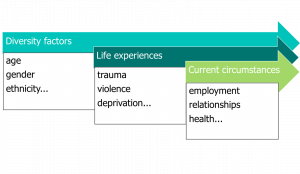Specific sub-groups
Earlier sections of this evidence resource have highlighted the importance of a personalised approach to working with people on probation. Such an approach requires consideration of relevant personal circumstances, including individual needs, strengths and expectations, and relevant diversity factors. When we talk specifically about diversity, our focus is upon the protected characteristics (for example age, gender, race) specified within the Equality Act 2010. This legislation sets out requirements for public bodies to address diversity and equality issues. In summary, those subject to the general equality duty must, in the exercise of their functions, have due regard to the need to:
- eliminate unlawful discrimination, harassment and victimisation and other conduct prohibited by the Act
- advance equality of opportunity between people who share a protected characteristic and those who do not
- foster good relations between people who share a protected characteristic and those who do not.
The video below, produced by the Equality and Human Rights Commission, provides more information about the nine protected characteristics.
Disclaimer: an external platform has been used to host this video. Recommendations for further viewing may appear at the end of the video and are beyond our control.
While this section of the evidence base considers specific sub-groups, it must always be borne in mind that individuals are shaped through differing combinations of interconnected and overlapping characteristics, experiences and circumstances. For example, intersectionality, a term introduced by Professor Kimberlé Crenshaw back in 1989, recognises that a person’s interactions with the world are not just solely based on one aspect of their identity but are rather layered and multifaceted. A whole person approach is required, recognising that overlapping needs is the norm for many people. Next: Young adults
Next: Young adults



